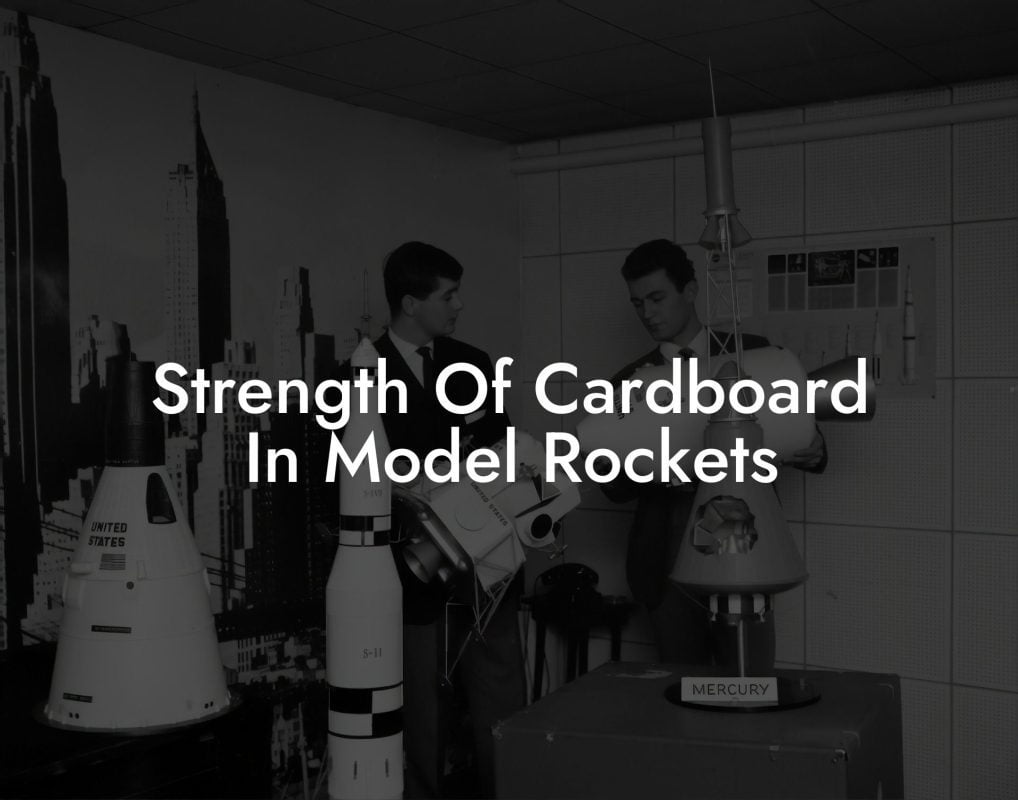Imagine the rush of adrenaline as your model rocket soars into the sky, leaving a trail of excitement and wonder in its wake. Welcome to the world of powerful model rockets, where innovation meets adventure and the boundaries of possibility are pushed to new heights.
Quick Links to Useful Sections
- What Makes a model rocket Powerful?
- The Anatomy of a Powerful Model Rocket
- Advanced Materials for Powerful Model Rockets
- Propulsion Systems for Maximum Power
- Electronics and Avionics for Enhanced Performance
- Powerful Model Rockets in Action
- Resources and community Support: Your Next Steps
- Frequently Asked Questions: Powerful Model Rockets
What Makes a model rocket Powerful?
A powerful model rocket is not just about speed and altitude; it's about the perfect blend of design, engineering, and technology coming together to create an unforgettable experience. From advanced materials to cutting-edge propulsion systems, every component plays a critical role in unleashing the full potential of your rocket.
Whether you're a seasoned enthusiast or just starting out, understanding the key factors that contribute to a rocket's power is essential for building and launching a successful model. Let's dive into the world of powerful model rockets and explore the secrets behind their impressive performance.
The Anatomy of a Powerful Model Rocket
A powerful model rocket consists of several critical components, each designed to work in harmony to achieve optimal performance. From the nose cone to the recovery system, every part plays a vital role in the rocket's success.
- Nose Cone: The nose cone is the tip of the rocket, responsible for reducing air resistance and protecting the payload during ascent.
- Body Tube: The body tube is the main structure of the rocket, housing the payload, recovery system, and electronics.
- Fins: Fins provide stability and control during flight, ensuring the rocket stays on course and reaches its desired altitude.
- Motor Mount: The motor mount is the backbone of the rocket's propulsion system, securely holding the motor in place and transferring thrust to the body tube.
- Recovery System: The recovery system, including parachutes or streamers, ensures a safe and controlled descent back to Earth.
By understanding the role of each component, you can optimize your rocket's design and construction to achieve maximum power and performance.
Looking For The Best Model Rocket Kits? You'll Love These:
Advanced Materials for Powerful Model Rockets
The materials used in your model rocket can significantly impact its performance and durability. From lightweight yet strong body tubes to heat-resistant motor mounts, the right materials can make all the difference.
- Carbon Fiber: Carbon fiber is a popular choice for model rockets due to its exceptional strength-to-weight ratio, making it ideal for body tubes and fins.
- Fiberglass: Fiberglass is a durable and affordable material often used for nose cones and motor mounts.
- Kevlar: Kevlar is a heat-resistant material used in motor mounts and recovery systems to protect against the intense heat generated during launch.
By selecting the right materials for your model rocket, you can ensure a powerful and reliable performance that will leave you and your spectators in awe.
Propulsion Systems for Maximum Power
The propulsion system is the heart of your model rocket, providing the thrust needed to reach incredible altitudes and speeds. From traditional chemical motors to advanced hybrid systems, the right propulsion system can make all the difference.
- Chemical Motors: Chemical motors are the most common type of propulsion system, using a fuel and oxidizer combination to generate thrust.
- Hybrid Motors: Hybrid motors combine the benefits of solid fuel and liquid oxidizers, offering increased efficiency and control.
- Electric Motors: Electric motors are a newer development in model rocketry, using electric propulsion systems to generate thrust.
By choosing the right propulsion system for your model rocket, you can unlock its full potential and experience the thrill of a powerful launch.
Electronics and Avionics for Enhanced Performance
Electronics and avionics play a critical role in modern model rockets, providing the brains behind the brawn. From altitude tracking to stabilization systems, advanced electronics can take your model rocket to new heights.
- Altitude Tracking: Altitude tracking systems use sensors and GPS to monitor the rocket's ascent and provide real-time data.
- Stabilization Systems: Stabilization systems use gyroscopes and accelerometers to maintain the rocket's stability and control during flight.
- Deployment Systems: Deployment systems use electronics to control the release of parachutes or streamers, ensuring a safe and controlled descent.
By integrating advanced electronics and avionics into your model rocket, you can unlock new levels of performance and precision.
Powerful Model Rockets in Action
From local launches to international competitions, powerful model rockets are pushing the boundaries of what's possible. Let's take a look at some of the most impressive model rockets in action.
- Record-Breaking Launches: Explore the world of record-breaking model rocket launches, where enthusiasts push the limits of speed and altitude.
- Competition Rockets: Discover the high-stakes world of model rocket competitions, where teams and individuals compete for top honors.
- Experimental Rockets: Delve into the world of experimental model rockets, where innovators are pushing the boundaries of design and technology.
By exploring the world of powerful model rockets in action, you can gain inspiration and insights to take your own model rocketry skills to the next level.
Resources and community Support: Your Next Steps
Whether you're just starting out or a seasoned enthusiast, having access to the right resources and community support is essential for building and launching powerful model rockets.
- Online Forums: Join online forums and discussion groups to connect with other model rocket enthusiasts, share knowledge, and learn from experts.
- Local Clubs: Find local model rocket clubs and organizations to meet fellow enthusiasts, attend launches, and participate in competitions.
- Tutorials and Guides: Explore online tutorials and guides to improve your skills and stay up-to-date with the latest techniques and technologies.
By tapping into these resources and community support, you can take your model rocketry skills to new heights and unlock the full potential of powerful model rockets.
Frequently Asked Questions: Powerful Model Rockets
Here are some frequently asked questions about powerful model rockets, covering topics from design and construction to safety and performance.
1. What makes a model rocket powerful?
A powerful model rocket is a combination of advanced design, materials, and propulsion systems that work together to achieve exceptional performance.
2. What are the most important components of a powerful model rocket?
The most important components include the nose cone, body tube, fins, motor mount, and recovery system, each playing a critical role in the rocket's performance and safety.
3. How do I choose the right propulsion system for my model rocket?
The right propulsion system depends on your rocket's design, size, and performance goals. Research and experiment with different options to find the best fit for your model rocket.
4. What safety precautions should I take when launching a powerful model rocket?
Always follow safety guidelines and regulations, ensure a safe launch site, and wear protective gear to minimize risks and ensure a successful launch.
5. How can I improve my model rocket's performance?
Continuously experiment with new designs, materials, and propulsion systems, and stay up-to-date with the latest techniques and technologies to optimize your model rocket's performance.
Looking For The Best Model Rocket Kits? You'll Love These:
Useful Interruption: Dive deeper into the world of Model Rockets with our most popular sections. If there is anything you think is missing or anything you would love for us to write about, just give us a shout.
- Getting Started & Basics With Model Rockets
- Model Rocket Design, Build & Customization
- Model Rocket Propulsion & Engine Technology
- Model Rocket Launch Techniques & Recovery
- Model Rocket Advanced Rocketry & Innovations
- Model Rocket DIY and Customization
- Model Rocket Equipment Reviews & Digital Tools
- Community, Competitions & Education
- Model Rocket Troubleshooting & FAQs
- Model Rocket Bonus/Seasonal & Niche Topics
A group of model rocket enthusiasts gathered at a field for their weekly launch event. Among them was Dave, a seasoned builder known for pushing the limits of hobby rocketry. This time, he had outdone himself.
“Ladies and gentlemen,” Dave announced, dramatically pulling a cloth off his latest creation, “I present to you: The Kraken!”
The crowd gasped. This wasn’t just a model rocket—it was a monster. The thing stood 8 feet tall, had six clustered engines, and was covered in enough duct tape to qualify as a classified aerospace project.
“Dave,” muttered Steve, the cautious safety officer, “Have you, uh… done the math on this?”
“Math?” Dave scoffed. “I built it in my garage at 3 a.m. with parts from eBay. This is an art piece, Steve.”
The countdown began.
5…
4…
3…
2…
1…
The engines ignited with a BOOM, and The Kraken shot up… kind of. It immediately did a violent barrel roll, narrowly missing the spectators before skyrocketing at an angle that could only be described as “legally questionable.”
The crowd collectively ducked as The Kraken flew straight over the adjacent cornfield, where Old Man Jenkins, the grumpiest farmer in town, was minding his business.
KABOOM!
The rocket disappeared behind the barn. A moment later, a flaming piece of Estes igniter wire landed at Steve’s feet. The silence was deafening.
And then—an unmistakable sound echoed across the field.
Jenkins’ shotgun being cocked.
“DAVE!!!” Steve shouted. “RUN.”
And that was the day Dave invented the first-ever biologically powered rocket booster: pure adrenaline.
To this day, nobody knows where The Kraken landed, but legend has it, it still haunts the skies, terrifying unsuspecting drones and low-flying birds.















